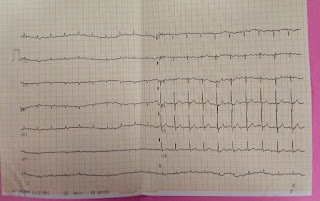A 42 year old female patient with multiple health events since birth.
I have been given this case to solve in an attempt to understand the topic of "patient clinical data analysis"todevelop my competency in reading and comprehending clinical data including history, clinical findings, investigations and come up with a diagnosis and treatment plan.
My analysis of the patient\"s problems:-
problems in the order of priority....
1.Swelling of face and abdomen
2.Headache(migraine)
3.sleep deprivation
4.Excecise induced fatigue
5.Left sided weakness
6.oliguria
7.Rashes.
My analysis of the problems:-
1.Swelling of face and abdomen
swelling started at the age of 1 year and the patient is still suffering from swelling in some conditions like....
emotional stress,eating some foods which are uncompaitable for her ,smoking etc.
It might be due to progression od G6PD into haemolytic crisis.
G6PD DEFICIENCY:-
It is a X-linked inherited disease. In G6PD deficiency HMP shunt pathway is affected leading to decrease in production of NADPH.NADPH maintains the reduced gluthathion levels which maintains the integrity of the RBC.
In G6PD deficiency levels of reduced gluathione are less and it leads to fragility of RBC inturn leads to haemolysis.
Differential diagnosis for swelling:-
. Cardiac failure
.kidney problems
.chronic severe anaemia.
Triggeing factors
1.Foods---fava beans
2.Drugs--antimalarials
3.Infections
4.Smoke
5.exertion.
Investigations:-
Complete blood picture
peripheral smear
Enzyme detection - G6PD level should be detected.
Genetic testing.
Treatment:-
1.she is on RIBOSE for swelling.
2.Avoid exposure to triggering factors
3.salt restriction
4.Blood transfusions
5.Antioxidants vitamins
2.Head ache (migraine)
She has severe haed ache since 2 yrs of age . Head ache is sudden in onset and very severe.she develops Aura before developing headache.
Aura..... she develops rainbow colors , temporary blindnes.
Left hand numbness
fall into left side (ataxia)
stuttering of speech
vertigo
Diagnosis:
Above comlpaints are suggestive of hemiplegia migraine.
Triggering factors for migraine:
Intense physical activity
skipping of meals
travelling
Exposure to smoke
stress
use of borth control pills
decreased sleep.
Investigations:
1.CT and MRI
2.Tests of heart and blood vessels to rule out blood clots.
TREATMENT:-
She has taken TRIPTANS for migraine
Other medications can be used are: CGRP inhibitors.
3.Sleep deprivation:-
onset.... since birth
Duration of sleep .... 2 to 4 hrs and No REM sleep.
possible causes
1.AMPD1 deficiency can cause sleep disturbances because adenosine is an inhibitory neurotrasmittor so ot should help in sleep.
2. G6PD deficiency impaired in glycolysis so glycine is not formed well. Glycine also an inhibitory neurotransmitter
TREATMENT TAKEN BY HER:--
1.L-serine ---- works like glycine in brain
so it helps in better sleep.
2.Cimetidine
4. Excercise induced fatigue
possible causes:
1.AMPD1 Deficiency
Lack of ATP hence the person gets easily tired.
2.Oxidative stress
from excess of free radicals because of G6PD deficiency
3.past history
shows parents to be chain smokers which increases the oxidative stress
TREATMENT GIVEN:-
1.RIBOSE..... helped her too because it provides ATP.
5.Left sided weakness
Numbness in left side of face
Loss of function on left side of the body.
She had this type of weakness at the time of migraine attack.
POSSIBLE DIAGNODIS:-
Hemiplegic migraine.
6.Oliguria
1.Due to G6PD deficiency there is oxidative stress causing kidney damage.
Because ... reduced production of NADPH and ATP and leads to loss of ions and decreased urine production.
2.It may be due to WNK1 gene mutation, kidney infections
INVESTIGATIONS:---
1.complete urine examination
2.USG
7.Rashes
She was diagnosed as BACHETS syndrome,
which is an autoimmune disorder, which causes Vasculitis, rashes, blurred vision due to improper vlood supply to optic nerve.
INVESTIGATIONS:--
1.Pathergy test
2.OCT
3.skin prick test.
Other problems:---
1. PCOD
2.Fractures
3.loss of hair
4.Excessive growth of hair on the body
5.osteoarthritis
6.Anhydrosis due to WNK1 gene mutation.




Comments
Post a Comment